Groundwater Overexploitation and Land Subsidence in the Messara Basin, Crete: Integrating Land Use, Hydrolithology and Basin-Scale Potentiometry with InSAR
Abstract
1. Introduction
2. The Study Area
3. Background of Hydrogeological Research, Key Studies, and Groundwater Overexploitation
4. Land Cover and Use
5. Geological and Hydrolithological Setting
5.1. Geological Setting
5.2. Hydrolithological Setting
5.2.1. Post-Alpine-Basin Fill
5.2.2. Alpine Formations—Surrounding Mountains
6. Hydrogeological Setting
6.1. Shallow Wells (Unconfined Aquifers) and Surface Water Reservoirs
6.2. Deep Wells (Deep Aquifer Systems)
6.3. Groundwater Network
6.4. Groundwater Dynamics
6.4.1. Water Level Data—Survey Periods
- ▪
- End of the wet season 2021: 17 May–5 June 2021.
- ▪
- End of the dry season 2021: 20 September–9 October 2021.
- ▪
- End of the wet season 2023: 22 May–10 June 2023.
- ▪
- End of the dry season 2023: 18 September–7 October 2023.
6.4.2. Water Level Data–Results
7. Discussion
8. Conclusions
- Extensive and persistent cones of depression dominate the western and southwestern Geropotamos sub-Basin and the central Messara plain. Hydraulic heads commonly fall below sea level by the end of the dry season, with interannual declines reaching several tens of meters in the central Basin between 2021 and 2023.
- While seasonal drawdown–recovery cycles are evident across the monitoring network, recovery remains incomplete in heavily abstracted zones, indicating a state of chronic overdraft and unsustainable aquifer stress.
- Independent EGMS data reveal spatially coherent subsidence collocated with zones of major head decline, particularly within thick Plio–Pleistocene successions. This correlation confirms a hydro-mechanical link between groundwater depletion, vertical ground deformation, and potential infrastructure risk.
- ▪
- Targeted abstraction reductions in identified hotspots
- ▪
- Systematic metering and permitting of high-capacity deep wells
- ▪
- Efficiency upgrades and seasonal demand management in agriculture
- ▪
- Pilot, well-instrumented managed aquifer recharge (MAR) schemes, particularly on permeable alluvial fans, and Aquifer Storage and Recovery (ASR) trials in suitable inland deep wells to bank winter surplus and dampen dry-season cones
- ▪
- Expanding the observation-well network with telemetered pressure and conductivity sensors to enable real-time data acquisition and improve spatial coverage.
- ▪
- Harmonizing reference datums across monitoring campaigns to ensure consistency and comparability of water-level measurements.
- ▪
- Continuing routine InSAR analysis to track ground deformation trends, particularly in subsidence-prone zones.
- ▪
- Publishing seasonal dashboards that integrate hydraulic head data, abstraction volumes, and ground motion metrics to enhance transparency, stakeholder engagement, and evidence-based decision-making.
Supplementary Materials
Author Contributions
Funding
Data Availability Statement
Acknowledgments
Conflicts of Interest
Abbreviations
| EGMS | European Ground Motion Service |
| b.s.l. | Below Sea Level |
| CLMS | Corine Land Monitoring Service |
| ELSTAT | Hellenic Statistical Authority |
| UAA | Utilized Agricultural Area |
| IGME | Institute of Geology and Mineral Exploration |
| HSGME | Hellenic Survey of Geology and Mineral Exploration |
| ADSCO | Associated Drilling and Supply Company (Overseas) |
| IGSR | Institute for Geology and Subsurface Research |
| LLRO | Local Land Reclamation Organization |
| LIS | Land Improvement Service |
| FFHC | Freedom From Hunger Campaign |
| MWSE | Municipal Water and Sewage Enterprise |
| FAO | Food and Agriculture Organization |
| UNDP | United Nations Development Program |
| UNESCO | United Nations Educational Scientific and Cultural Organization |
| HNMS | Hellenic National Meteorological Service |
| WGS 84 | World Geodetic System 1984 |
| MAR | Managed Aquifer Recharge |
| ASR | Aquifer Storage and Recovery |
References
- Zhang, Y.; Xue, Y.Q.; Wu, J.C.; Yu, J.; Wei, Z.X.; Li, Q.F. Land Subsidence and Earth Fissures Due to Groundwater Withdrawal in the Southern Yangtze Delta, China. Environ. Geol. 2008, 55, 751–762. [Google Scholar] [CrossRef]
- Loupasakis, C.; Angelitsa, V.; Rozos, D.; Spanou, N. Mining Geohazards—Land Subsidence Caused by the Dewatering of Opencast Coal Mines: The Case Study of the Amyntaio Coal Mine, Florina, Greece. Nat. Hazards 2014, 70, 675–691. [Google Scholar] [CrossRef]
- Raspini, F.; Loupasakis, C.; Rozos, D.; Adam, N.; Moretti, S. Ground Subsidence Phenomena in the Delta Municipality Region (Northern Greece): Geotechnical Modeling and Validation with Persistent Scatterer Interferometry. Int. J. Appl. Earth Obs. Geoinf. 2014, 28, 78–89. [Google Scholar] [CrossRef]
- Svigkas, N.; Papoutsis, I.; Loupasakis, C.; Tsangaratos, P.; Kiratzi, A.; Kontoes, C. Land Subsidence Rebound Detected via Multi-Temporal InSAR and Ground Truth Data in Kalochori and Sindos Regions, Northern Greece. Eng. Geol. 2016, 209, 175–186. [Google Scholar] [CrossRef]
- Papoutsis, I.; Kontoes, C.; Alatza, S.; Apostolakis, A.; Loupasakis, C. InSAR Greece with Parallelized Persistent Scatterer Interferometry: A National Ground Motion Service for Big Copernicus Sentinel-1 Data. Remote Sens. 2020, 12, 3207. [Google Scholar] [CrossRef]
- Kamali, M.; Papoutsis, I.; Loupasakis, C.; Abuelgasim, A.; Omari, K.; Kontoes, C. Monitoring of Land Surface Subsidence Using Persistent Scatterer Interferometry Techniques and Ground Truth Data in Arid and Semi-Arid Regions: The Case of Remah, UAE. Sci. Total Environ. 2021, 776, 145946. [Google Scholar] [CrossRef] [PubMed]
- Mertikas, S.; Papadaki, E.; Paleologos, E. Radar Interferometry Techniques for Monitoring Subsidence Induced by Excessive Groundwater Pumping in Crete, Greece. In Proceedings of the Fringe Workshop, Frascati, Italy, 30 November–4 December 2009. [Google Scholar]
- Kaskara, M.; Barberopoulou, A.; Papoutsis, I.; Kontoes, C.; Ganas, A.; Karastathis, V. Analysis of the Deformation Pattern along the Subduction Zone of Crete, Greece, from Multi-Temporal ERS Data. In Proceedings of the Fringe 2015 Workshop, Frascati, Italy, 23–27 March 2015. ESA SP-731, May 2015. [Google Scholar]
- Michalakis, I.; Tsolaki, E.; Loupasakis, C.; Voudouris, K.; Kontoes, C. Groundwater level dynamics of the Messara Basin, Crete Island. Bulletin of the Geological Society of Greece, Special Publication 10, Extended Abstract GSG 2022-162. In Proceedings of the 16th International Congress of the Geological Society of Greece, Patras, Greece, 17–19 October 2022; pp. 553–554. [Google Scholar]
- Beeby-Thompson, A.; Paver, G.L. Report on the Survey and Exploration of Groundwater Resources in the Messara Plain Area (Covering Work Carried Out up to November 1951); Associated Drilling & Supply Co. (Overseas) Ltd. (ADSCO): London, UK, 1951. [Google Scholar]
- e-Messara. Messara: Rice Cultivation in Petrokefali over Time. Available online: https://e-mesara.gr/mesara-ryzokalliergeia-sto-petrokefali-sto-perasma-toy-chronoy/ (accessed on 5 March 2024). (In Greek).
- Cretan Magazine. The Old Watermills of Messara (Part A). Available online: https://www.cretanmagazine.gr/i-palii-neromyli-tis-mesaras-meros-a/ (accessed on 30 November 2024). (In Greek).
- Cretan Magazine. The Old Watermills of Messara (Part B). Available online: https://www.cretanmagazine.gr/i-palii-neromyli-tis-mesaras-meros-v/ (accessed on 30 November 2024). (In Greek).
- Hellenic Agricultural Organization (ELGO)—DIMITRA. School of Rural Education, Heraklion Prefecture—Agricultural School of Messara. Available online: https://www.elgo.gr/index.php?option=com_content&view=article&id=3110:diek-p-e-irakleiou-me-eidikotita-tis-thermokipiakes-kataskeves-kai-kalliergeies&catid=294&Itemid=2399 (accessed on 3 December 2024). (In Greek).
- Aronis, G. General Hydrological Survey of the Island of Crete (Includes Geological Map of Crete, Scale 1:500,000); Institute for Geology and Subsurface Research (IGSR): Athens, Greece, 1949. [Google Scholar]
- National Printing Office. On Land Improvement Projects. Royal Greek Government Gazette; Royal Decree 3881/30 October 1958, Issue 181, 30 October 1958; National Printing Office: Athens, Greece, 1958. (In Greek) [Google Scholar]
- National Printing Office. On the Organization, Structure, Responsibilities, etc. of the Regional Land Improvement Service. Greek Government Gazette; Royal Decree. 13 September 1959, Issue 220A, 12 October 1959; National Printing Office: Athens, Greece, 1959. (In Greek) [Google Scholar]
- Local Land Reclamation Organization of Messara—Zone A’. Official Website. Available online: http://www.toebazoni.gr/ (accessed on 30 November 2024). (In Greek).
- Ministry of Environment and Energy. Special Secretariat for Water. 1st Revision of the River Basins Management Plan of the Water District of Crete (EL13), Interim Phase 2: Deliverable 14—Study of the Design and Organization of the Consultation and Recording of Social Partners; December 2016. Available online: https://wfdver.ypeka.gr/wp-content/uploads/2017/05/EL13_1REV_P14_Organosi_Diavouleusis_v01.pdf#page=4.45 (accessed on 5 December 2024). (In Greek).
- Ministry of Environment and Energy. General Secretariat for Water. 2nd Revision of the River Basin Management Plan of the Water District of Crete (EL13); 28 May 2024. Available online: https://wfdver.ypeka.gr/wp-content/uploads/2024/07/EL13_2REV_sdlap.pdf#page=71.08 (accessed on 5 July 2024). (In Greek).
- Ministry of Environment and Energy. General Secretariat for Water. River Basin Management Plans (as Defined in Article 13 and Annex VII of Directive 2000/60/EC and Article 10 and Annex VII of Presidential Decree 51/2007). Available online: https://wfdver.ypeka.gr/en/management-plans-en/approved-management-plans-en (accessed on 5 July 2024).
- Water Directorate of Crete. Decentralized Administration of Crete. Monitoring–Protection of Water Resources. Available online: https://www.apdkritis.gov.gr/el/Παρακολούθηση-Προστασία-Υδατικών-Πόρων (accessed on 3 May 2024).
- Re, R. Study of Water Resources and their Exploitation for Irrigation in Eastern Crete, Greece/Evaporation in Southern Crete. Technical Note No 4 (Provisional Document) (FAO/SF: 166/GRE); Food and Agriculture Organization of the United Nations (FAO): Iraklion, Greece, 1969. [Google Scholar]
- Del Brassinne, J. Study of Water Resources and Their Exploitation for Irrigation in Eastern Crete, Greece/Estimation des Besoins en eau des Cultures en Messara. Technical Note No 6 (Provisional Document) (FAO/SF: 166/GRE); Food and Agriculture Organization of the United Nations (FAO): Iraklion, Greece, 1969. [Google Scholar]
- Underhill, H.V.; Schenkeveld, M.M.; Goodwill, I.M. Study of Water Resources and Their Exploitation for Irrigation in Eastern Crete, Greece/Trials of Mathematical Watershed Model for Runoff Simulation. Technical Note No 10 (Provisional Document) (FAO/SF: 166/GRE); Food and Agriculture Organization of the United Nations (FAO): Iraklion, Greece, 1970. [Google Scholar]
- Underhill, H.V.; Schenkeveld, M.M.; Goodwill, I.M. Study of Water Resources and Their Exploitation for Irrigation in Eastern Crete, Greece/Hydrology and Water Balances of the Messara Plain. Technical Note No 11 (Provisional Document) (FAO/SF: 166/GRE); Food and Agriculture Organization of the United Nations (FAO): Iraklion, Greece, 1970. [Google Scholar]
- Dietrich, G. Study of Water Resources and Their Exploitation for Irrigation in Eastern Crete, Greece/Hydrogeology of Western Messara. Technical Note No 13 (Provisional Document) (FAO/SF: 166/GRE); Food and Agriculture Organization of the United Nations (FAO): Iraklion, Greece, 1970. [Google Scholar]
- Underhill, H.V. Study of Water Resources and Their Exploitation for Irrigation in Eastern Crete, Greece/Hydrology and Water Balances of the Messara Plain. Technical Note No 13 (Pro-visional Document) (FAO/SF: 166/GRE); Food and Agriculture Organization of the United Nations (FAO): Iraklion, Greece, 1970. [Google Scholar]
- Dietrich, G.; Kilakos, J. Groundwater Quality in the Messara Plain in Eastern Crete, Greece. Working Document No. 18 (FAO/SF: 17/GRE); Food and Agriculture Organization of the United Nations (FAO): Iraklion, Greece, 1971. [Google Scholar]
- Samuelsson, B. Study of Water Resources and Their Exploitation for Irrigation in Eastern Crete, Greece/Hydrology and Water Balances of the Messara Plain. Working Document, No 34 (FAO/AGL/SF: 31/GRE); Food and Agriculture Organization of the United Nations (FAO): Iraklion, Greece, 1971. [Google Scholar]
- Chatziagorakis, D. Study of Water Resources and Their Exploitation for Irrigation in Eastern Crete, Greece/Geometric and Hydraulic Characteristics of the Aquifers in the Western Messara. Technical Note No 104/Supplement to Technical Note No 101 (Provisional Document) (FAO/AGL/SF: 17/GRE); Food and Agriculture Organization of the United Nations (FAO): Iraklion, Greece, 1971. [Google Scholar]
- Brenzik, M.; Chatziagorakis, D. Study of Water Resources and Their Exploitation for Irrigation in Eastern Crete, Greece/Geometric and Hydraulic Characteristics of the Aquifers in the Western Messara. Technical Note No 101, Volume 1—Text (Provisional Document) (FAO/AGL/SF: 17/31/GRE); Food and Agriculture Organization of the United Nations (FAO): Iraklion, Greece, 1971. [Google Scholar]
- Brenzik, M.; Chatziagorakis, D. Study of Water Resources and Their Exploitation for Irrigation in Eastern Crete, Greece/Geometric and Hydraulic Characteristics of the Aquifers in the Western Messara. Technical Note No 101, Volume 2—Graphs (Provisional Document) (FAO/AGL/SF: 17/31/GRE); Food and Agriculture Organization of the United Nations (FAO): Iraklion, Greece, 1971. [Google Scholar]
- Brenzik, M.; Chatziagorakis, D. Study of Water Resources and Their Exploitation for Irrigation in Eastern Crete, Greece/Geometric and Hydraulic Characteristics of the Aquifers in the Eastern Messara. Technical Note No 102, Volume 1—Text (Provisional Document) (FAO/AGL/SF: 17/GRE); Food and Agriculture Organization of the United Nations (FAO): Iraklion, Greece, 1971. [Google Scholar]
- Ridder, N.A.; Dietrich, G. Study of Water Resources and Their Exploitation for Irrigation in Eastern Crete, Greece/Drillings and Pumping Tests in the Messara. Working Document, No 26 (FAO/AGL/SF: 31/GRE); Food and Agriculture Organization of the United Nations (FAO): Iraklion, Greece, 1972. [Google Scholar]
- Dietrich, G. Study of Water Resources and Their Exploitation for Irrigation in Eastern Crete, Greece/Hydrogeology of Eastern Messara. Working Document, No 37 (FAO/AGL/SF: 31/GRE); Food and Agriculture Organization of the United Nations (FAO): Iraklion, Greece, 1972. [Google Scholar]
- Michalakis, I.; Tsolaki, E. Water Wells in Crete: Distribution by Municipality, Use, and Ownership—Results of a Systematic Inventory in Greece; Bulletin of the Geological Society of Greece, Special Publication Vol. H; Extended Abstract 209; Geological Society of Greece: Athens, Greece, 2025; pp. 981–986. [Google Scholar]
- Water Directorate of Crete. Drought of the Current Hydrological Year—Proposed Water Scarcity Measures; Decentralized Administration of Crete: Crete, Greece, 2024. Available online: https://apdkritis.gov.gr/el/node/4951 (accessed on 3 May 2024).
- Michalakis, I. Hydrogeological Conditions and Sustainability Challenges in the Messara Basin, Crete. In Proceedings of the 10th International Symposium on Sustainable Mineral Processing (SIPS 2024), Crete, Greece, 20–24 October 2024; p. 493. [Google Scholar]
- Institute of Geology and Mineral Exploration (IGME). Recording and Evaluation of the Hydrogeological Characteristics of the Groundwater and Aquifer Systems of Greece. Water District EL13; IGME: Rethymno, Greece, 2009. (In Greek) [Google Scholar]
- Hellenic Survey of Geology and Mineral Exploration (HSGME). Groundwater Monitoring Network of Greece. Available online: https://gaia.igme.gr/portal/apps/dashboards/ae94b7fa2a504a6ab171b96657f46c35 (accessed on 14 January 2025).
- Voudouris, K.; Mavromatis, T.; Krinis, P. Assessing runoff in future climate conditions in Messara valley in Crete with a rainfall-runoff model. Meteorol. Appl. 2013, 20, 182–190. [Google Scholar] [CrossRef]
- Varouchakis, E.A. Spatiotemporal Geostatistical Modelling of Groundwater Level Variations at Basin Scale. Hydrol. Res. 2018, 49, 1131–1142. [Google Scholar] [CrossRef]
- Varouchakis, E.A.; Kalaitzaki, E.; Trichakis, I.; Corzo Perez, G.A.; Karatzas, G.P. An Integrated Method to Study and Plan Aquifer Recharge. Hydrol. Res. 2023, 54, 1–13. [Google Scholar] [CrossRef]
- Croke, B.; Cleridou, N.; Kolovos, A.; Vardavas, I.; Papamastorakis, J. Water Resources in the Desertification-Threatened Messara Valley of Crete: Estimation of the Annual Water Budget Using a Rainfall–Runoff Model. Environ. Model. Softw. 2000, 15, 387–402. [Google Scholar] [CrossRef]
- Vardavas, I.M.; Papamastorakis, J.; Fountoulakis, A.; Manousakis, M. Water Resources in the Desertification-Threatened Messara Valley of Crete: Estimation of Potential Lake Evaporation. Ecol. Model. 1997, 102, 363–374. [Google Scholar] [CrossRef]
- Kritsotakis, M. Water Resources Management in Mesara Valley of Crete. Ph.D. Thesis, Technical University of Crete, Chania, Greece, 2010. (In Greek). [Google Scholar]
- Kritsotakis, M.; Tsanis, I. An Integrated Approach for Sustainable Water Resources Management of Messara Basin, Crete, Greece. Eur. Water 2009, 27–28, 15–30. [Google Scholar]
- Pipatpan, S.; Blindow, N. Geophysical Saltwater-Intrusion Mapping in Timbaki, Crete: Selection and Application of Geophysical Methods for Aquifer Characterization and Detection of Saline Intrusions; Institute for Geophysics, Westfälische Wilhelms-Universität Münster: Münster, Germany, 2005. [Google Scholar]
- Paritsis, S.N. Simulation of Seawater Intrusion into the Tymbaki Aquifer, South Central Crete, Greece; Department of Management of Water Resources of the Region of Crete: Heraklion, Greece, 2005. [Google Scholar]
- Zacharioudakis, G.; Paramastorakis, D. Conceptual Model and Model Idealisation Report of Tymbaki Basin in South Crete; Office for Official Publications of the European Communities: Luxembourg, 2005. [Google Scholar]
- Zacharioudakis, G.; Paramastorakis, D. Tymbaki Basin Transient Groundwater Flow Model Design and Calibration; Report within MEDIS Project: Towards Sustainable Water Use on Mediterranean Islands. European Commission Contract No. EVK1-CT-2001-00092; European Commission: Brussels, Belgium, 2005.
- Hellenic National Meteorological Service (HNMS). HNMS Stations Network (Official Website). Available online: https://emy.gr/en/hnms-stations (accessed on 15 February 2025).
- Hellenic National Meteorological Service (HNMS). Climate Atlas of Greece (Official Website). Available online: http://climatlas.hnms.gr/sdi/ (accessed on 15 February 2025).
- CORINE Land Cover. Available online: https://land.copernicus.eu/en/products/corine-land-cover (accessed on 12 February 2025).
- CORINE Land Cover 1990 (vector), Europe, 6-yearly—Version 2020_20u1, May 2020 (CLC1990). Available online: https://doi.org/10.2909/5c1f2e03-fcba-47b1-afeb-bc05a47bada0 (accessed on 12 February 2025).
- CORINE Land Cover 2000 (vector), Europe, 6-yearly—Version 2020_20u1, May 2020 (CLC2000). Available online: https://doi.org/10.2909/8b85b479-6afb-42c6-817c-11d1a5260b83 (accessed on 12 February 2025).
- CORINE Land Cover 2006 (vector), Europe, 6-yearly—Version 2020_20u1, May 2020 (CLC2006). Available online: https://doi.org/10.2909/93eede6e-c196-40e3-9253-7f2237b49de1 (accessed on 12 February 2025).
- CORINE Land Cover 2012 (vector), Europe, 6-yearly—Version 2020_20u1, May 2020 (CLC2012). Available online: https://doi.org/10.2909/916c0ee7-9711-4996-9876-95ea45ce1d27 (accessed on 12 February 2025).
- CORINE Land Cover 2018 (vector), Europe, 6-yearly—Version 2020_20u1, May 2020 (CLC2018). Available online: https://doi.org/10.2909/71c95a07-e296-44fc-b22b-415f42acfdf0 (accessed on 12 February 2025).
- Hellenic Statistical Authority (ELSTAT). Agricultural Census 2000, 2009, 2020; Dataset Request ID: 49,101/12-03-2025. Available online: https://www.statistics.gr/en/statistics/-/publication/SPG31/2020 (accessed on 14 March 2025).
- Institute of Geology and Mineral Exploration (IGME). Geological Map of Greece, Melambes Sheet, 1st ed.; Scale 1:50,000; IGME: Athens, Greece, 1985. [Google Scholar]
- Institute of Geology and Mineral Exploration (IGME). Geological Map of Greece, Timbakion Sheet, 1st ed.; Scale 1:50,000; IGME: Athens, Greece, 1984. [Google Scholar]
- Institute of Geology and Mineral Exploration (IGME). Geological Map of Greece, Antiskarion Sheet, 1st ed.; Scale 1:50,000; IGME: Athens, Greece, 1985. [Google Scholar]
- Institute of Geology and Mineral Exploration (IGME). Geological Map of Greece, Epano Archanae Sheet, 1st ed.; Scale 1:50,000; IGME: Athens, Greece, 1994. [Google Scholar]
- Institute of Geology and Mineral Exploration (IGME). Geological Map of Greece, Akhendhrias Sheet, 1st ed.; Scale 1:50,000; IGME: Athens, Greece, 1984. [Google Scholar]
- Institute of Geology and Mineral Exploration (IGME). Geological Map of Greece, Mochos Sheet, 1st ed.; Scale 1:50,000; IGME: Athens, Greece, 1989. [Google Scholar]
- Institute of Geology and Mineral Exploration (IGME). Geological Map of Greece, Ano Viannos Sheet, 1st ed.; Scale 1:50,000; IGME: Athens, Greece, 2002. [Google Scholar]
- Hellenic Survey of Geology and Mineral Exploration (HSGME). Geological Map of Greece, Melambes Sheet, 2nd ed.; Scale 1:50,000; HSGME: Acharnes, Greece, 2023. [Google Scholar]
- Hellenic Survey of Geology and Mineral Exploration (HSGME). Geological Map of Greece, Tymbakion Sheet, 2nd ed.; Scale 1:50,000; HSGME: Acharnes, Greece, 2023. [Google Scholar]
- Hellenic Survey of Geology and Mineral Exploration (HSGME). Geological Map of Greece, Antiskarion Sheet, 2nd ed.; Scale 1:50,000; HSGME: Acharnes, Greece, 2023. [Google Scholar]
- Hellenic Survey of Geology and Mineral Exploration (HSGME). Geological Map of Greece, Epano Archanae Sheet, 2nd ed.; Scale 1:50,000; HSGME: Acharnes, Greece, 2023. [Google Scholar]
- Hellenic Survey of Geology and Mineral Exploration (HSGME). Geological Map of Greece, Achentrias Sheet, 2nd ed.; Scale 1:50,000; HSGME: Acharnes, Greece, 2023. [Google Scholar]
- Hellenic Survey of Geology and Mineral Exploration (HSGME). Geological Map of Greece, Mochos Sheet, 2nd ed.; Scale 1:50,000; HSGME: Acharnes, Greece, 2023. [Google Scholar]
- Hellenic Survey of Geology and Mineral Exploration (HSGME). Geological Map of Greece, Ano Viannos Sheet, 2nd ed.; Scale 1:50,000; HSGME: Acharnes, Greece, 2023. [Google Scholar]
- Water Directorate of Crete. Datasets; Decentralized Administration of Crete: Irakleion, Greece. Available online: https://data.apdkritis.gov.gr/search?s=&sort_by=changed&sort_order=DESC&f%5B0%5D=content_type%3Adataset (accessed on 27 January 2025).
- Hellenic Survey of Geology and Mineral Exploration (HSGME)/Regional Branch of Crete (RBC). Systematic Inventory of Water Wells of Every Use throughout the Country of Greece (2019–2023); Preliminary Technical Reports: Municipalities of Crete, Rethymno, Greece. Available online: https://eagme.gr/programs/bsamy-ii-b-systhmatikh-apografh-ydrogewtrhsewn-kathe-xrhshs-se-olh-thn (accessed on 4 December 2024).
- UNESCO. International Glossary of Hydrology; United Nations Educational, Scientific and Cultural Organization: Paris, France, 1992; p. 413. [Google Scholar]
- Kovalevsky, V.S.; Kruseman, G.P.; Rushton, K.R. Groundwater Studies: An International Guide for Hydrogeological Investigations; IHP-VI Series on Groundwater No. 3; UNESCO: Paris, France, 2004; ISBN 92-9220-005-4. [Google Scholar]
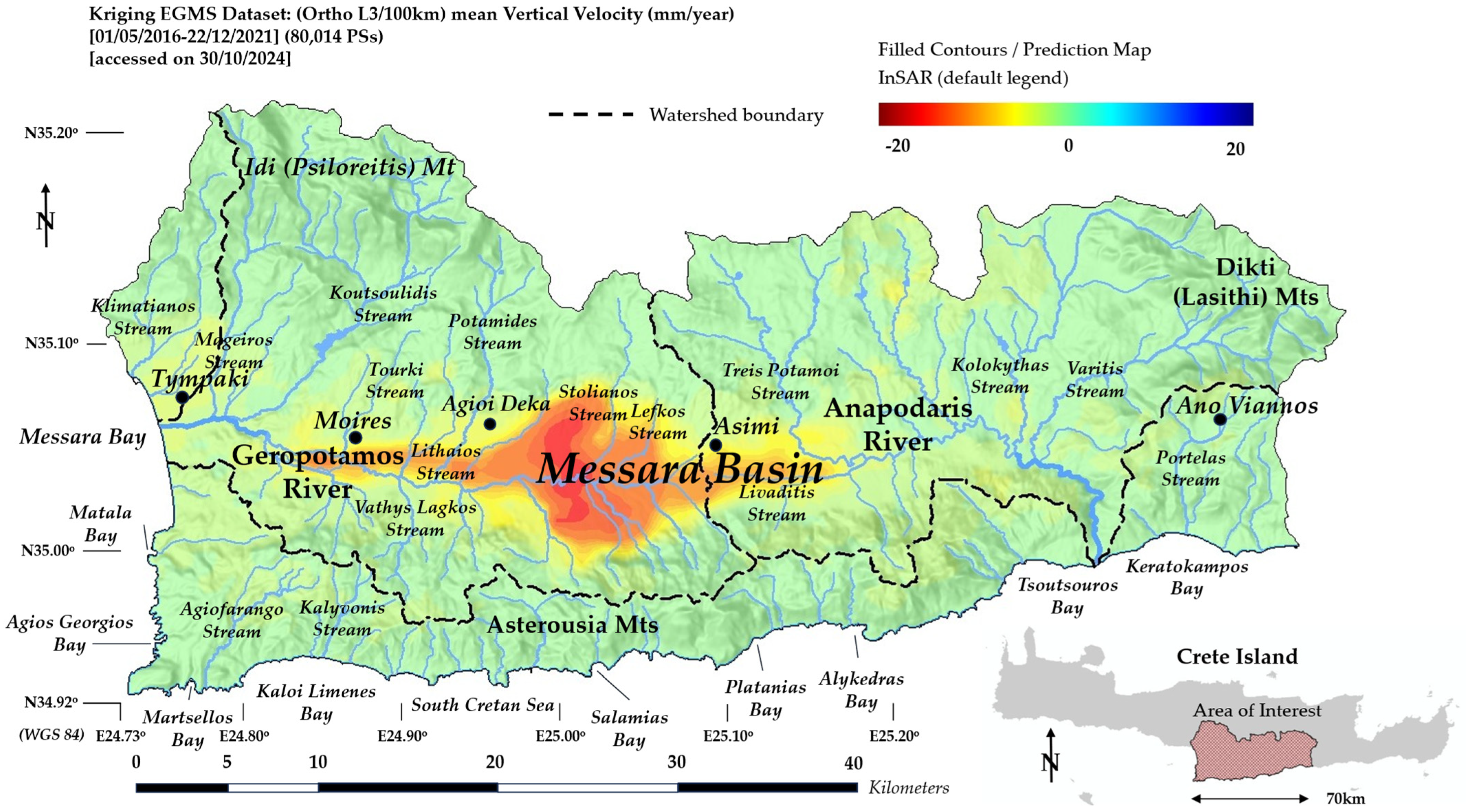
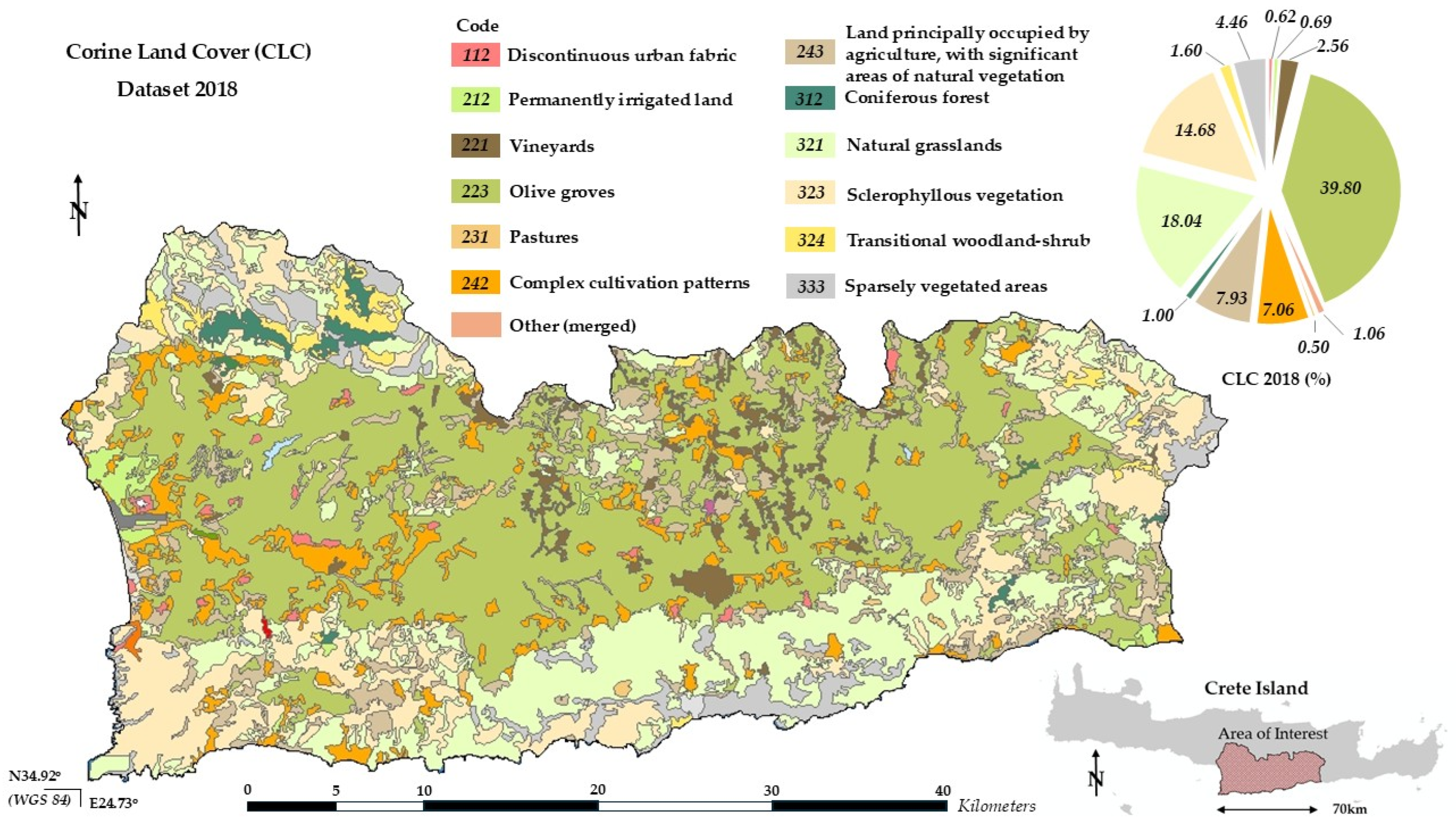
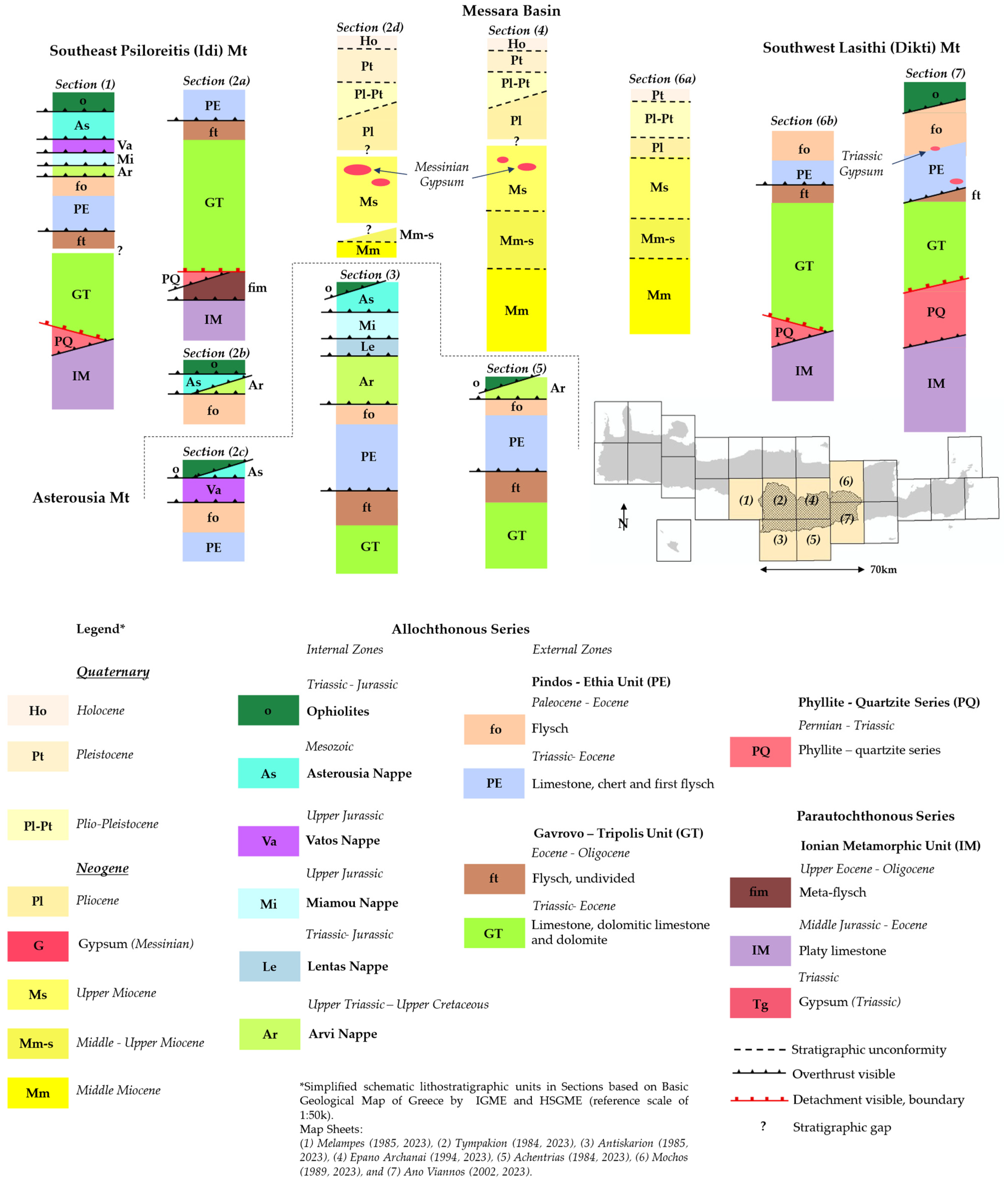
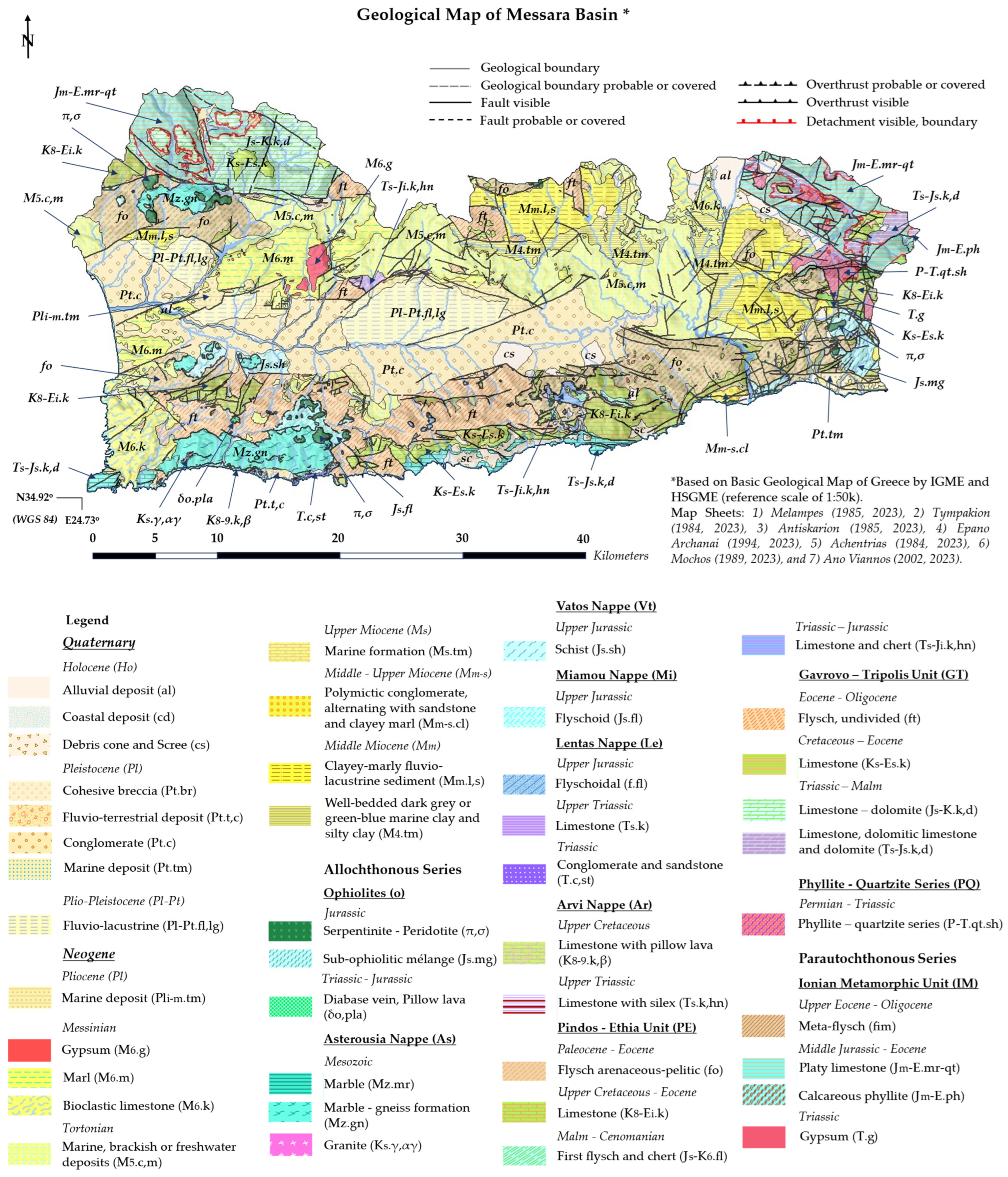
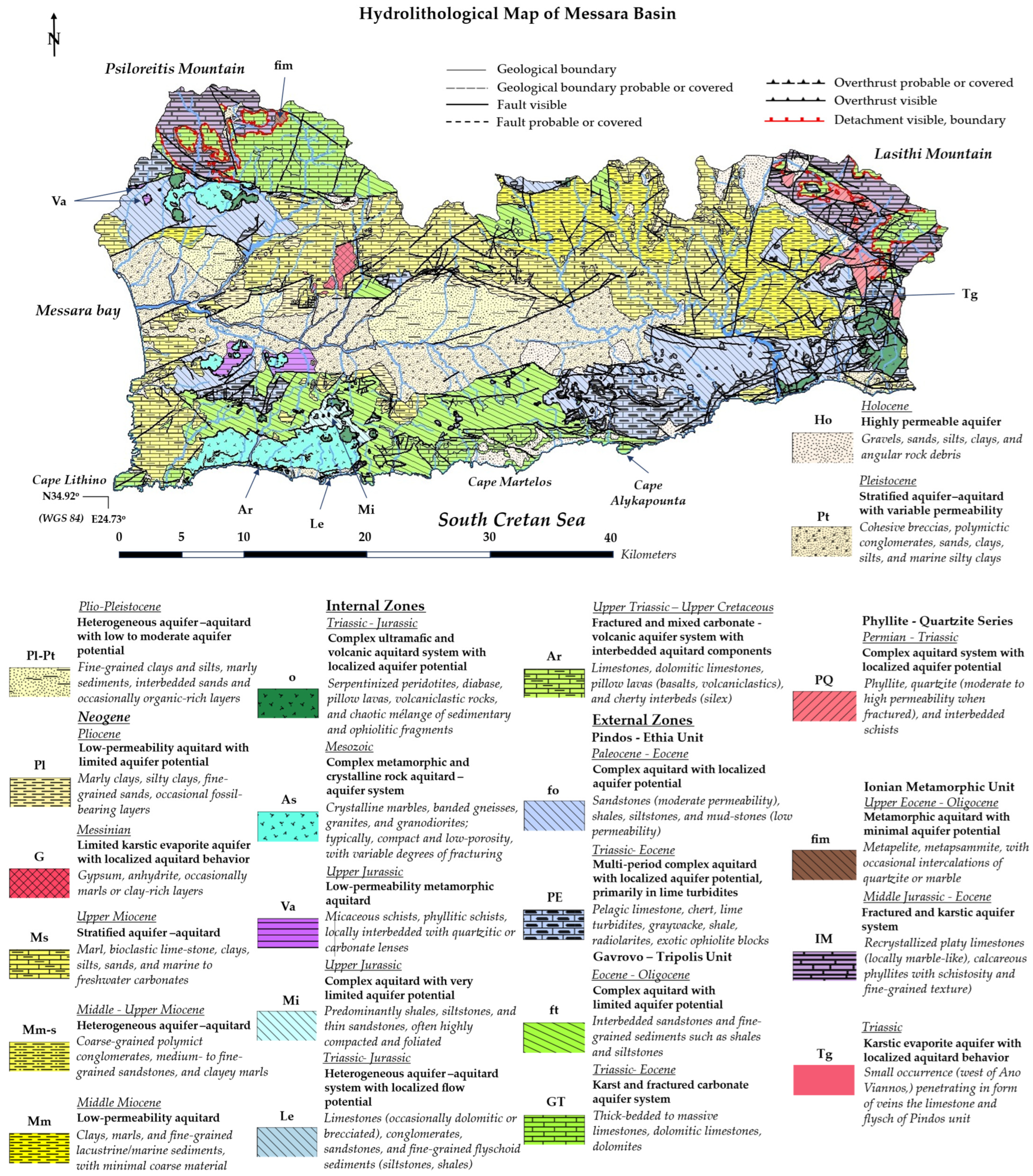
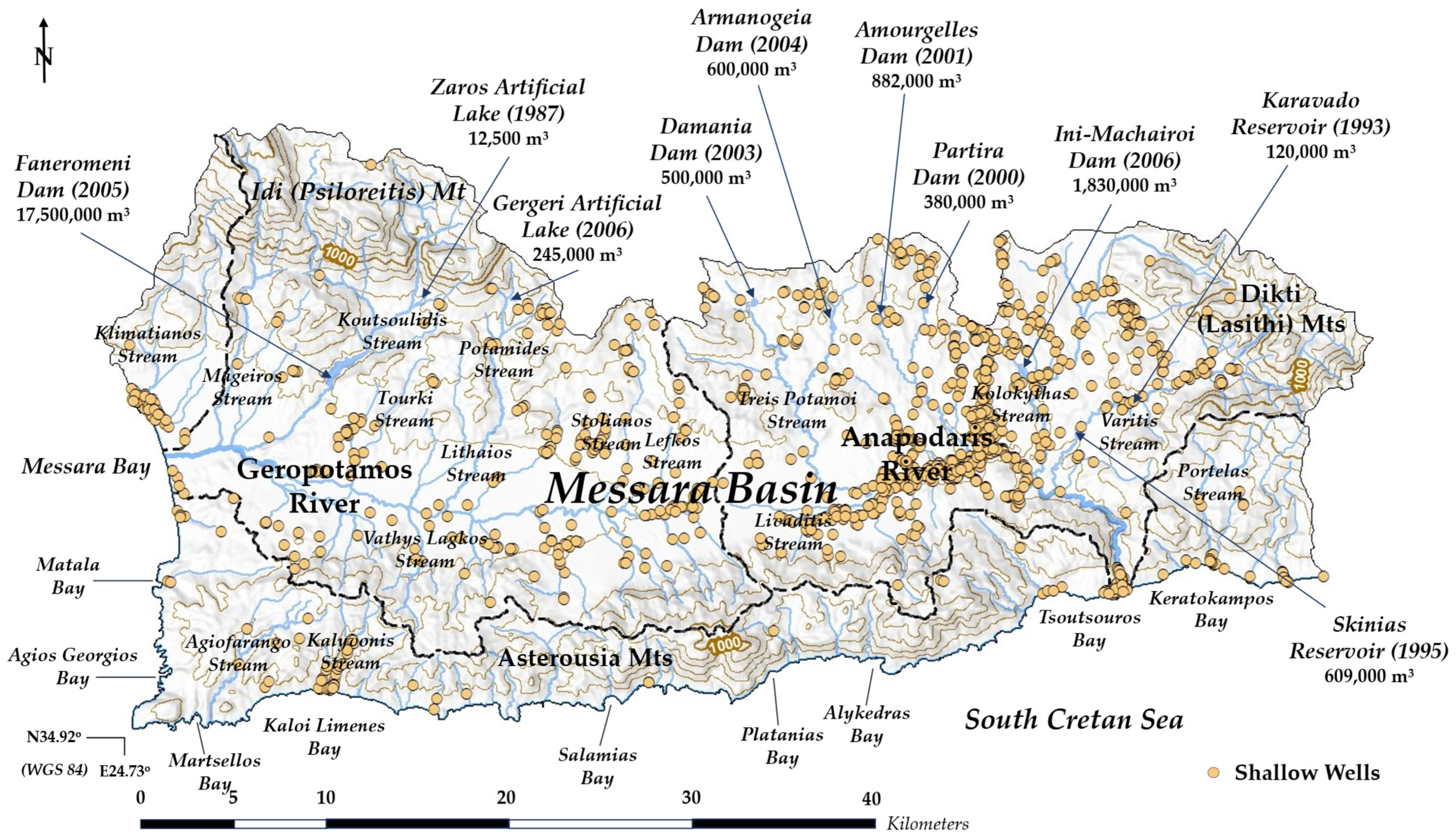
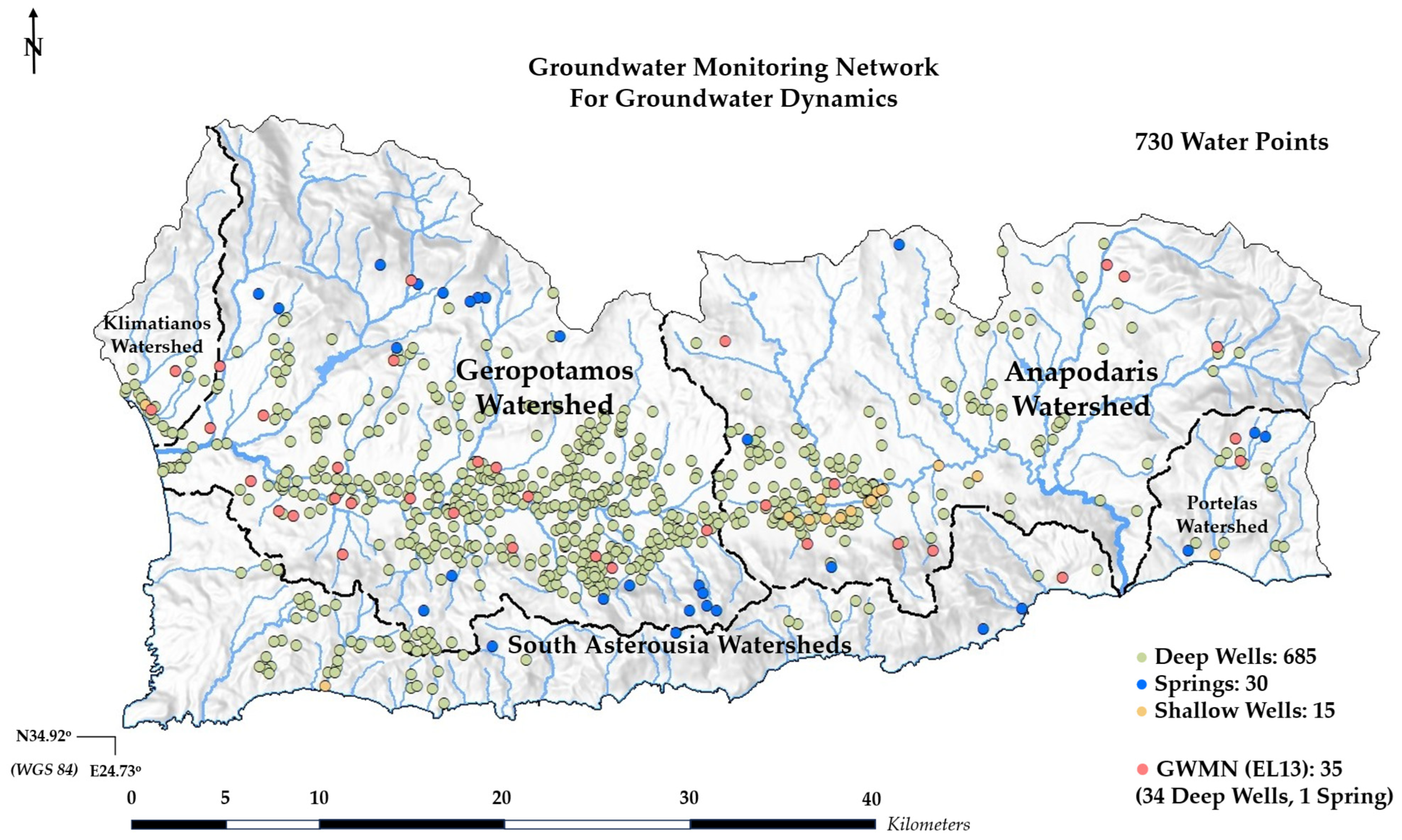
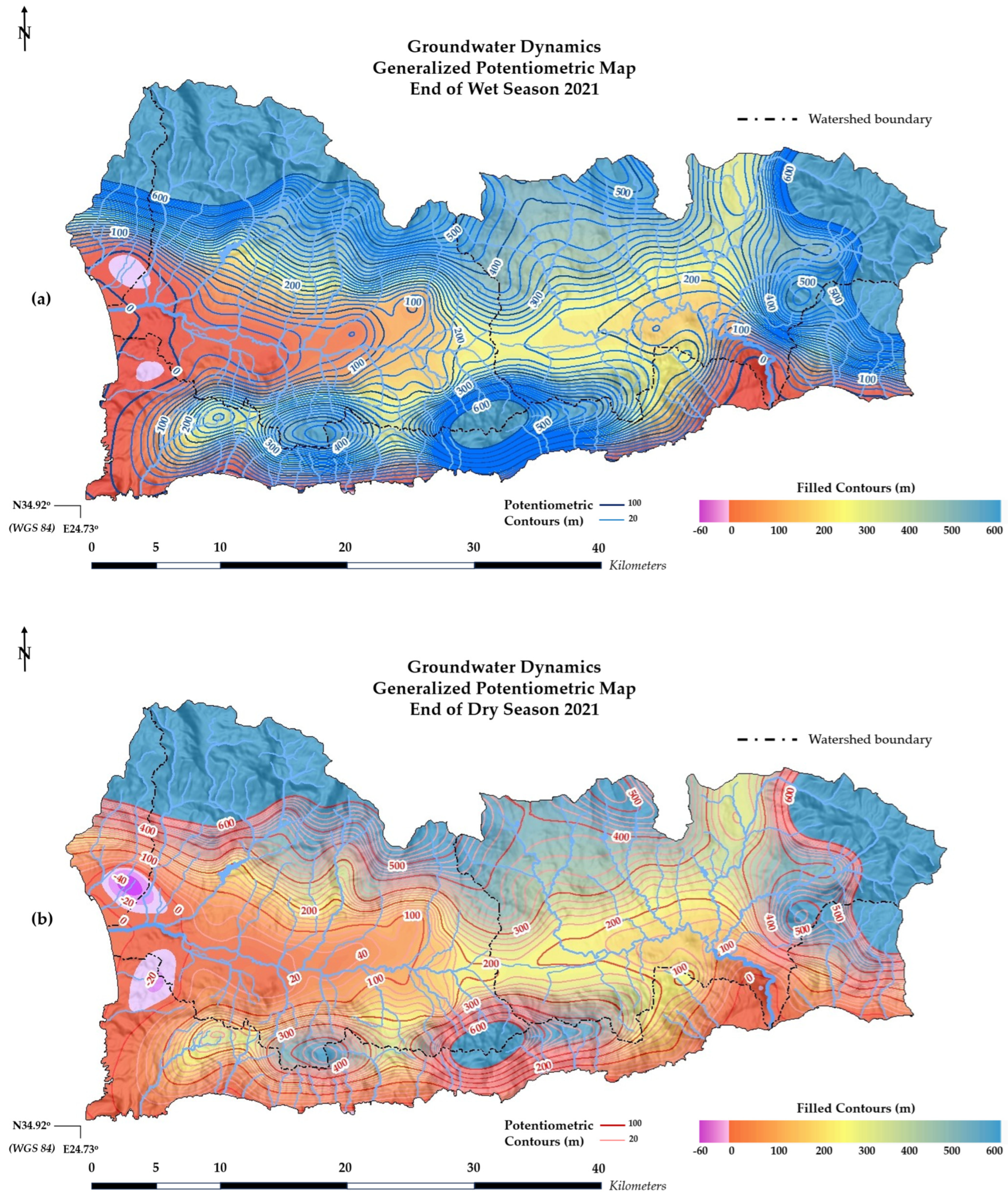
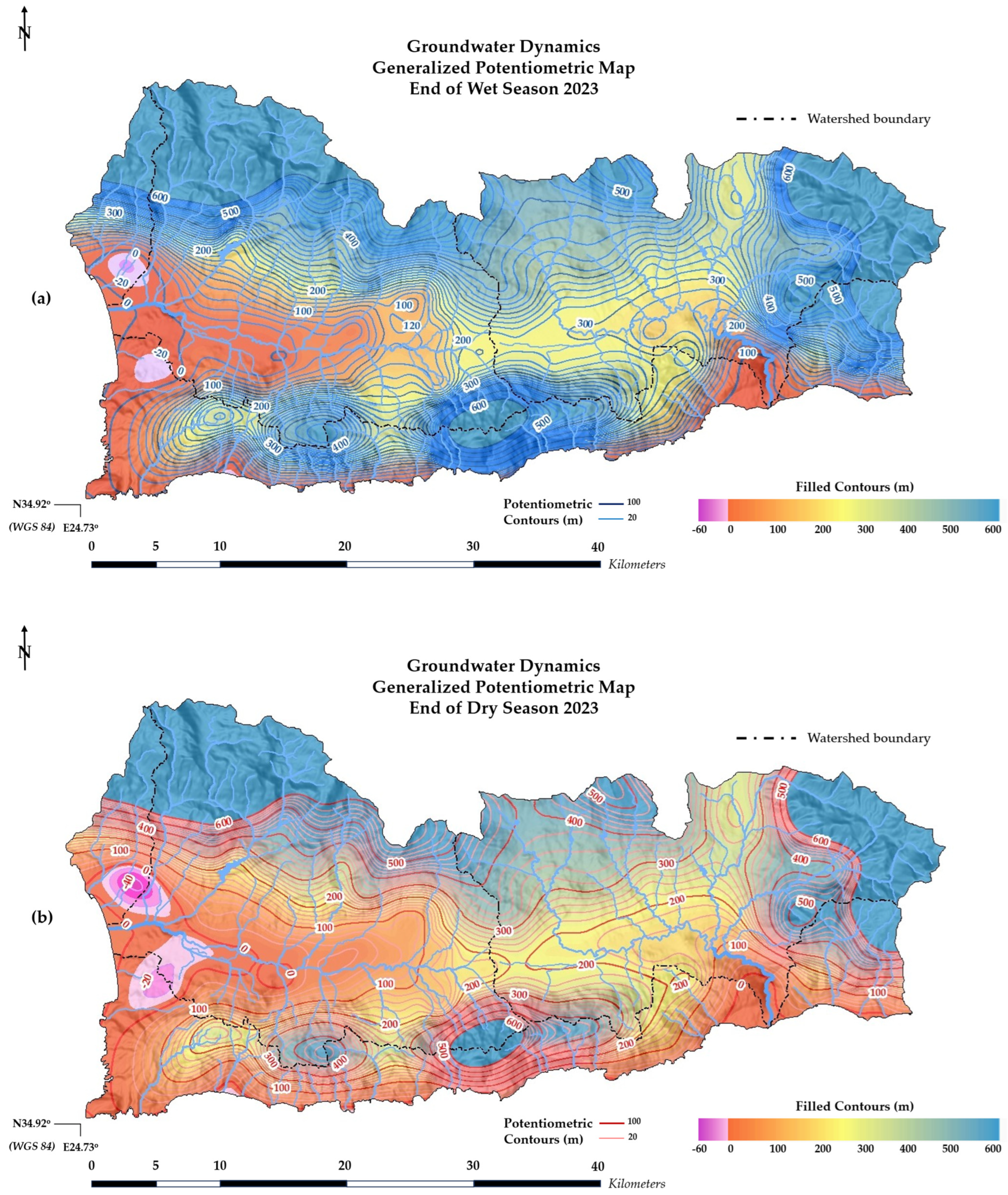
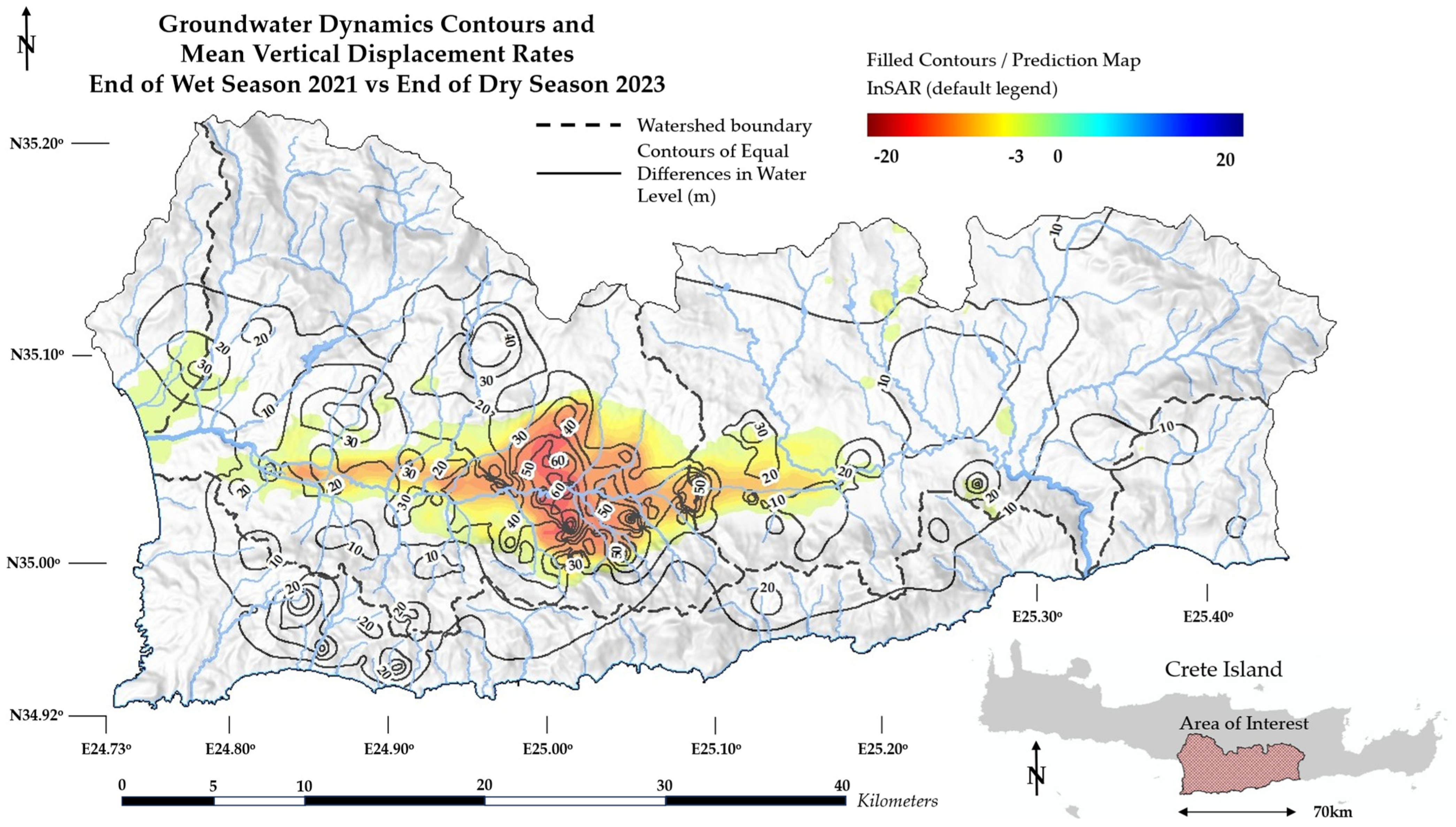
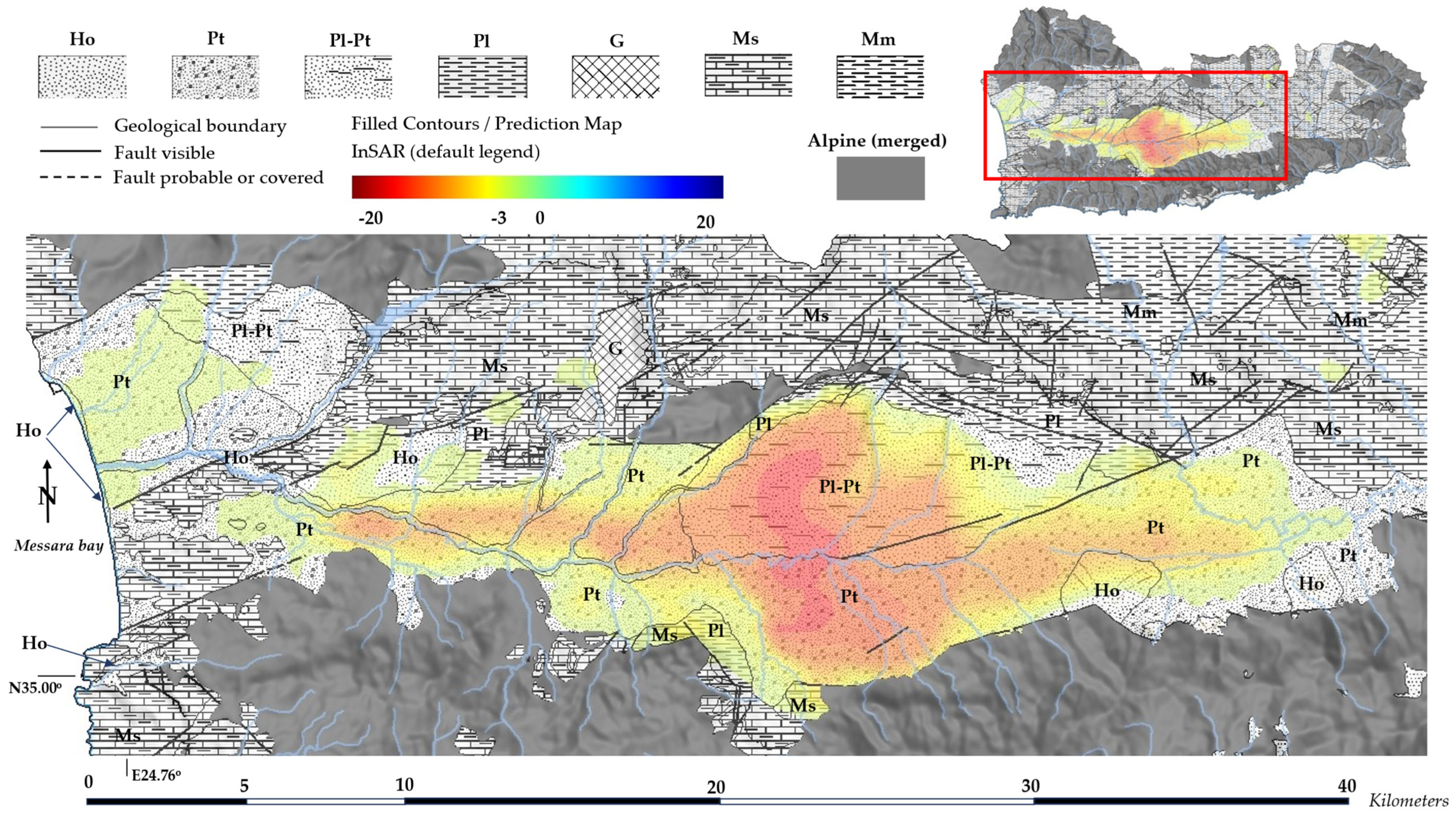
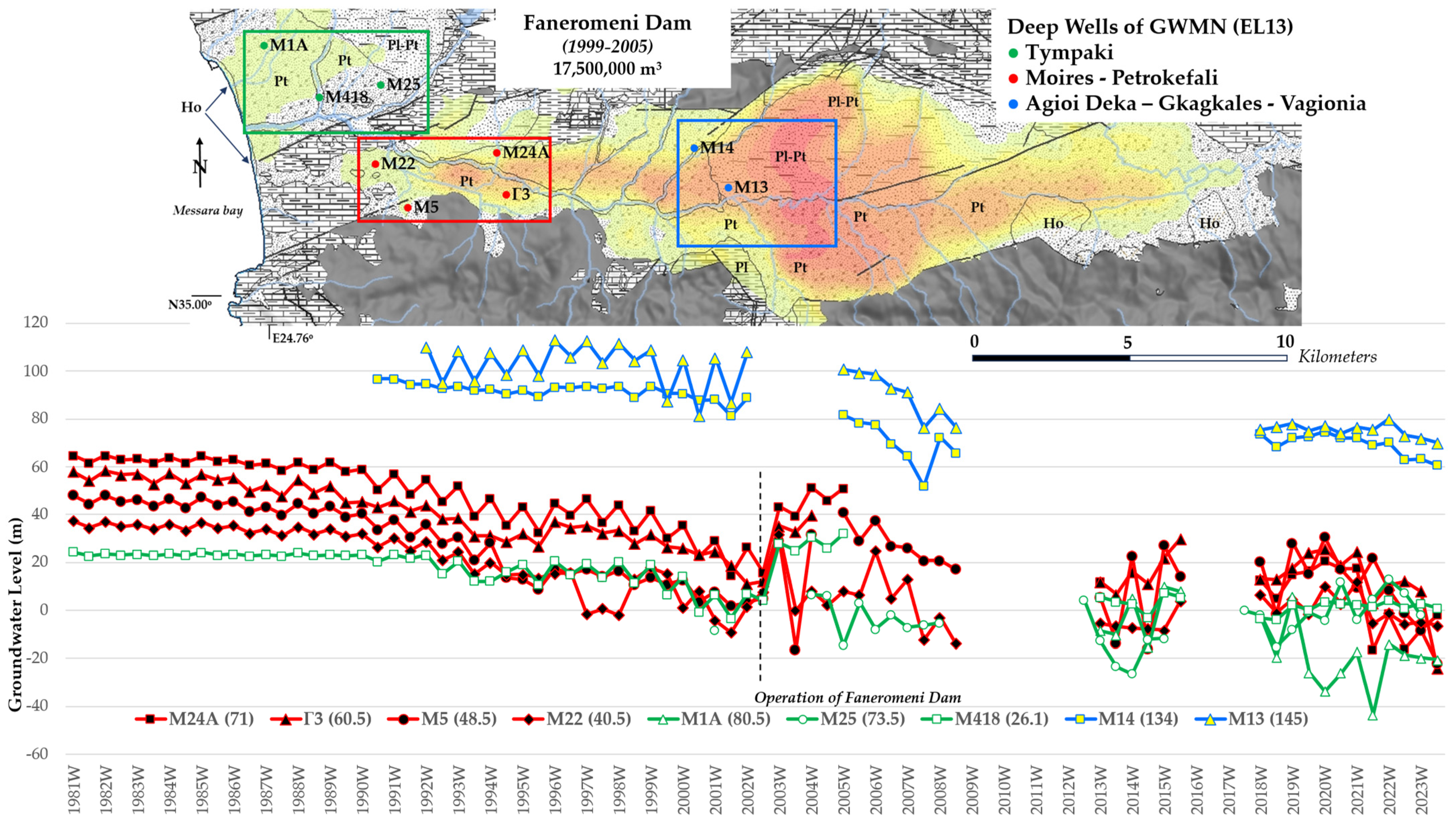
| 1990 | 2000 | 2006 | 2012 | 2018 | ||||||||
|---|---|---|---|---|---|---|---|---|---|---|---|---|
| Code | CLC Class | % | Km2 | % | Km2 | % | Km2 | % | Km2 | % | Km2 | |
| 112 | Discontinuous urban fabric | 0.52 | 8.00 | 0.54 | 8.26 | 0.52 | 7.91 | 0.62 | 9.45 | 0.62 | 9.47 | * Classes of Land Cover in the Study Area with spatial distribution greater than 0.5%. |
| 212 | Permanently irrigated land | 0.00 | 0.00 | 0.00 | 0.00 | 0.59 | 9.10 | 0.69 | 10.57 | 0.69 | 10.60 | |
| 221 | Vineyards | 4.33 | 66.32 | 3.73 | 57.18 | 3.99 | 61.09 | 2.56 | 39.30 | 2.56 | 39.30 | |
| 223 | Olive groves | 39.34 | 602.99 | 40.09 | 614.37 | 40.22 | 616.48 | 39.85 | 610.96 | 39.80 | 610.97 | |
| 231 | Pastures | 0.07 | 1.00 | 0.06 | 0.95 | 0.14 | 2.17 | 0.50 | 7.65 | 0.50 | 7.65 | |
| 242 | Complex cultivation patterns | 6.10 | 93.51 | 6.10 | 93.49 | 5.39 | 82.68 | 7.06 | 108.23 | 7.06 | 108.39 | |
| 243 | Land principally occupied by agriculture, with significant areas of natural vegetation | 6.62 | 101.43 | 7.06 | 108.24 | 7.34 | 112.53 | 7.93 | 121.50 | 7.93 | 121.75 | |
| 312 | Coniferous forest | 0.55 | 8.37 | 0.55 | 8.37 | 0.55 | 8.37 | 1.01 | 15.56 | 1.00 | 15.29 | |
| 321 | Natural grasslands | 18.25 | 279.66 | 17.84 | 273.44 | 17.64 | 270.39 | 18.02 | 276.21 | 18.04 | 276.98 | |
| 323 | Sclerophyllous vegetation | 15.50 | 237.59 | 15.61 | 239.24 | 14.80 | 226.86 | 14.52 | 222.53 | 14.68 | 225.39 | |
| 324 | Transitional woodland-shrub | 1.96 | 30.10 | 1.96 | 30.10 | 2.03 | 31.06 | 1.59 | 24.40 | 1.60 | 24.63 | |
| 333 | Sparsely vegetated areas | 5.79 | 88.69 | 5.78 | 88.55 | 6.21 | 95.14 | 4.39 | 67.35 | 4.46 | 68.41 | |
| 211 * | Non-irrigated arable land | 0.26 | 3.91 | 0.27 | 4.09 | 0.03 | 0.45 | 0.27 | 4.11 | 0.27 | 4.11 | |
| 512 * | Water bodies (Inland water) | 0.00 | 0.00 | 0.00 | 0.00 | 0.07 | 1.09 | 0.10 | 1.46 | 0.10 | 1.46 | |
Disclaimer/Publisher’s Note: The statements, opinions and data contained in all publications are solely those of the individual author(s) and contributor(s) and not of MDPI and/or the editor(s). MDPI and/or the editor(s) disclaim responsibility for any injury to people or property resulting from any ideas, methods, instructions or products referred to in the content. |
© 2025 by the authors. Licensee MDPI, Basel, Switzerland. This article is an open access article distributed under the terms and conditions of the Creative Commons Attribution (CC BY) license (https://creativecommons.org/licenses/by/4.0/).
Share and Cite
Michalakis, I.; Loupasakis, C.; Tsolaki, E. Groundwater Overexploitation and Land Subsidence in the Messara Basin, Crete: Integrating Land Use, Hydrolithology and Basin-Scale Potentiometry with InSAR. Land 2025, 14, 2124. https://doi.org/10.3390/land14112124
Michalakis I, Loupasakis C, Tsolaki E. Groundwater Overexploitation and Land Subsidence in the Messara Basin, Crete: Integrating Land Use, Hydrolithology and Basin-Scale Potentiometry with InSAR. Land. 2025; 14(11):2124. https://doi.org/10.3390/land14112124
Chicago/Turabian StyleMichalakis, Ioannis, Constantinos Loupasakis, and Eleni Tsolaki. 2025. "Groundwater Overexploitation and Land Subsidence in the Messara Basin, Crete: Integrating Land Use, Hydrolithology and Basin-Scale Potentiometry with InSAR" Land 14, no. 11: 2124. https://doi.org/10.3390/land14112124
APA StyleMichalakis, I., Loupasakis, C., & Tsolaki, E. (2025). Groundwater Overexploitation and Land Subsidence in the Messara Basin, Crete: Integrating Land Use, Hydrolithology and Basin-Scale Potentiometry with InSAR. Land, 14(11), 2124. https://doi.org/10.3390/land14112124









